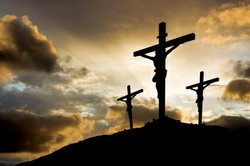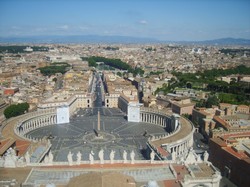Mary Magdalen was the first witness to the resurrection, and she is known as the apostle to the Apostles. But her life is played down in orthodox Christian literature, but there are elements in Gnostic literature in which Mary's story is treasured and retold. Some Gnostic literature holds her to have been Jesus' wife, a stance rejected by the church, which believes that Jesus was celibate. But what happened to Mary after the resurrection?. She seems to have kept a low profile, but there is a legend that proclaims that Mary fled to Gaul to escape persecution by the Jewish establishment and the Romans.
The Boat, the Mat and the Women: an enquiry into Christian legend
by frankbeswick
A mystery in Biblical study is why do some characters disappear from Christian writings. But there are possible clues.
The Boat and the Mat
An inquiry into Christian legend.
In 2004 an American dealer in antiques was touring the North Indian region when he was approached by a person who offered him a decrepit old mat which seemed to have Christian iconography: seven characters, five of them women, with one character larger than the others, who might have been Christ. Each is in a small boat, though if the legend is based on a journey by a group one boat would have sufficed. The characters have haloes and what may be the mark of the Christian cross on their foreheads. This old mat contains a story. The mat was radio-carbon dated to about 150A.D. Jeremy Pine, for that was the dealer's name, knew that he had his hand on a piece of early Christian culture, but he could not tell whether it was orthodox Christian or Gnostic, the Gnostics being a group of Christian sects differing from the Orthodox.
The Gnostics differed from Orthodox Christians in a number of ways, and they often differed from each other. But One important point stands out, they accepted the ministry of women, and placed great emphasis on Mary Magdalen. Let us get the point clear. Mary was not as Roman legend says a harlot. She was a female disciple who followed Christ with the others. She is wrongly conflated with other women, such as the woman taken in adultery, but there are differences of opinion on whether she is to be identified with Mary of Bethany. The Catholic church long accepted that she was, but the church exegetes have swung round to reject this tradition. This may be a mistake. Nor did she come from Magdala, which was not known by that name in Jesus' time. In fact her name may be connected with the term for greatness, so she was known as Mary the Great to early Christians on account of her being a woman who stood by Jesus as he was being crucified and as she was the first witness to the empty tomb and to the living Lord after the resurrection. Mary the Great!
There are suggestions in Gnostic literature, sometimes known as apocryphal gospels, those gospel accounts not selected for inclusion in the canon of Scripture with the four canonical gospels, that she continued to have revelations after Jesus' resurrection. This seemed to be a source of tension with the apostle Peter, who did not take what were basically mystical revelations. Mystics have always challeneged Church authorities, and over the centuries have either been suppressed or pressurised into public conformity by the ecclesiastical establishment. Furthermore, when mystics are female they are even less popular with the male clerical establishment The apocryphal gospel of Philip claims that after the ascension Jesus continued to speak to her in the heart, meaning that she received divine messaging from God. This made her an alternative source of authority in the church community. Differences of opinion between her and Peter began to arise. Whether this claim can be historically verified is doubtful, but not self-evidently incorrect.
Dispersal
Between the years 41 and 44 the church suffered a short, but savage persecution at the hands of Herod Agrippa the First, who decided to concentrate on leading Christian figures. He quickly seized James the brother of John and beheaded him. Peter was next on the list. He was arrested and held in the dungeons in chains. Herod's aim was to put Peter to trial before the Sanhedrin and execute him. It seems clear that Herod's intention was to take out the leaders of the Christian movement. But Peter was sprung from prison by the intervention of an angel, so Acts of the Apostles tells us, and he got away. He spent some time away from Judea, possibly going to Antioch. .
But John disappeared, possibly taking Jesus' mother Mary with him. The story is that he and Mary went to Ephesus, where the house where they were said to have lived in still stands. John is often identified with the disciple that Jesus loved, but this may not be correct, as John chapter 11 calls Lazarus the man that Jesus loved. Lazarus was the brother of Martha and Mary, who is often identified with Mary Magdalen. But Mary Magdalen was a top target for the persecutors. She was the witness to the risen Christ, a fact universally acknowledged by the whole Christian movement. Though not listed among the twelve apostles she was called the apostle to the apostles. Moreover, some Christians over the millennia have believed that she was Jesus' wife. Certainly, she anointed Jesus at the meal in Bethany, and at Jewish weddings the bride anoints the groom. In the garden where she met the risen Lord she addressed him as Rabbuni, a term one of whose several meanings can mean husband. She also made to embrace him, though Jesus informed her that he had not yet ascended to his Father. Gnostic sources sometimes say that Jesus and Mary sometimes kissed. Nothing can be concluded with certainty on this matter, but Jesus and Mary were very close. Mary Magdalen was undoubtedly a target for the persecutors. It was imperative to get her away. There were suggestions that she went to Ephesus with John, but this does not seem to have been a long term arrangement. Her presence at Ephesus seems to have not been observed by the church, if it happened. She needed a more distant location.
This takes us to the boat. The boat depicted on the mat is a small inshore craft unsuited to sea voyaging. But the legend has it that the exiles, Mary, Salome, Jesus' aunt two males, one a blind man that they cared for, an Egyptian maid who went with them just trusted themselves to God and the sea. They had no oars or sail, and so they just drifted. The claim that they had no oars or sail probably was legendary to symbolize that they were relying on God. Miraculously they were kept safe and drifted eventually to Southern Gaul, where the boat was washed ashore. How long the journey was we do not know, and we know not the starting point. But the exiles ended up in the south of modern France. They found somewhere to stay and settled down to live out their lives quietly. There seems to be a small Christian community there, who welcomed them. But they sought no publicity, as Roman persecution had the potential to be extensive. And Jesus was a claimant to the throne of David, a man executed for treason against Rome.
But the legend of their journey eventually spread through the empire and beyond. Certainly the mat containing images of the voyagers spread to India, where the ancient fabric was discovered.
Mary Magdalen
You might also like
Who was JesusTo understand Jesus you must realize that he was a mystery that theology trie...
Ministry in the church:women bishopsThe long awaited decision to have women bishops is major progress.







 Women of the Gospelson 10/11/2025
Women of the Gospelson 10/11/2025
 Religious Gardenson 08/25/2025
Religious Gardenson 08/25/2025
 Doctor of the Church: John Henry Newmanon 08/03/2025
Doctor of the Church: John Henry Newmanon 08/03/2025
 Restoring the Palm Houseon 07/16/2025
Restoring the Palm Houseon 07/16/2025



Comments
There is no set age. God calls when he wants
Thank you for your comment below, in answer to my previous observation and question.
Your answer that "The path to sanctity for each of us to respond to God in a unique way, according to His call" intrigues me.
Is there an age at and after which a call is heedable?
I made a spelling error when I should have said God calls us ALL to be saints. I recall when I was at theological college when a Jesuit gave us a spiritual thought on the matter, saying that we are all called to be saints in our own degree and particular way. The path to sanctity for each of us to respond to God in a unique way, according to His call
I made a spelling error when I should have said God calls us ALL to be saints. I recall when I was at theological college when a Jesuit gave us a spiritual thought on the matter, saying that we are all called to be saints in our own degree and particular way. The path to sanctity for each of us to respond to God in a unique way, according to His call
I made a spelling error when I should have said God calls us ALL to be saints. I recall when I was at theological college when a Jesuit gave us a spiritual thought on the matter, saying that we are all called to be saints in our own degree and particular way. The path to sanctity for each of us to respond to God in a unique way, according to His call
I made a spelling error when I should have said God calls us ALL to be saints. I recall when I was at theological college when a Jesuit gave us a spiritual thought on the matter, saying that we are all called to be saints in our own degree and particular way. The path to sanctity for each of us to respond to God in a unique way, according to His call
Thomas Aquinas thought that Al are called to be saints, but individuals vary in their capacity for sanctity. Imag8ne we are all like containers, each container is different, and thus has an individual capacity for sanctity. Where Joseph fits in this scheme l don't know, but God entrus5ed him with great responsibilities.
Thank you for your two comments below, in answer to my previous observation and question.
Online sources sometimes equate divine love with loving us all equally.
Is it accurate to imagine us all inspiring the same love by God and Jesus Christ or is it possible that some, along with John or Lazarus, Mary and Our Lady Mary, inspire being treasured?
(Where is Joseph in terms of being treasured beyond loving or being "just" loved?)
Whether ary Magdalene is to be identified with Mary of Bethany is unclear, and a matter of dispute among scholars.
We cannot be party to Jesus' inner feelings. We know that he treasured Mary Magdalen and his mother, but there was also the disciple whom Jesus loved, thought at one time to. be John, but probably Lazarus.